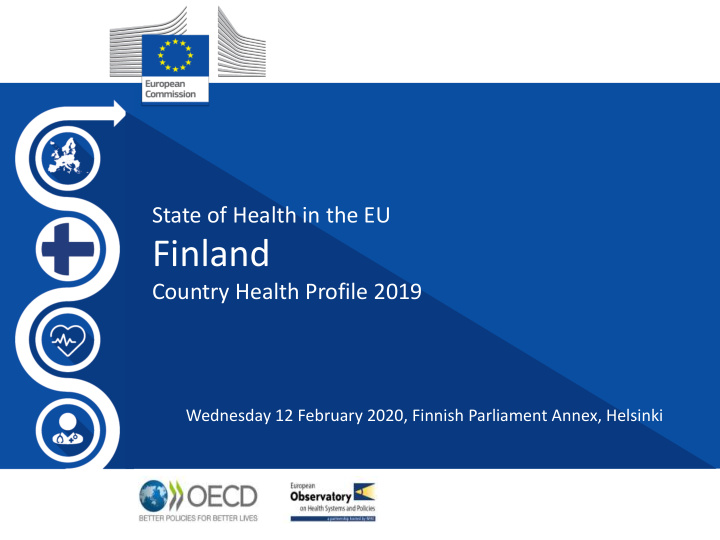



State of Health in the EU Finland Country Health Profile 2019 Wednesday 12 February 2020, Finnish Parliament Annex, Helsinki
Country Health Profile
How does the health status of the Finnish population compare with EU countries?
Life expectancy in Finland is about one year higher than EU average… but one year lower than leading countries
Inequalities in life expectancy by socioeconomic status in Finland are still large Eurostat Database (data refer to 2016) Mainly driven by differences in exposure to risk factors (e.g. smoking, alcohol)
Many years of life after age 65 are with chronic diseases and disabilities Life expectancy and healthy life expectancy at age 65 Eurostat Database (data refer to 2017) 60% of Finns aged 65 and over report having at least one chronic condition (compared with 55% in the EU as a whole)
What are some of the main risk factors to health?
Progress has been achieved in reducing smoking, but alcohol consumption and obesity remain important risk factors in Finland
How much does Finland spend on health compare with EU countries?
Health spending per capita in Finland is similar to the EU average… but less than in other Nordic countries • 75% of health spending is publicly funded (compared with 79% in the EU as a whole) • 9.2% of GDP is allocated to health (compared with 9.8% in the EU as a whole)
How does Finland compare in terms of access to care? (affordability and availability of services)
20% of health spending in Finland is paid out-of-pocket by households, mainly on pharmaceuticals, dental care and outpatient care
Less than 4% of people in Finland report unmet medical care needs , but the proportion is higher among low-income people (mainly because of waiting times )
Finland has relatively few doctors, but a high number of nurses Provides opportunities to expand the role of nurses in primary care and hospitals
What is the effectiveness of the Finnish health system?
Preventable mortality rates are slightly higher than the EU average, while mortality from treatable causes is significantly lower
Vaccination rate is high among children , but lower among older people Vaccination among older people has stalled and remains well below the recommended target (75%)
Avoidable hospital admissions for chronic diseases could be reduced through better management in primary care
Key findings
Key findings Life expectancy has increased substantially over the past two decades, but many years of life in old age are lived with chronic diseases and Health status disabilities. Socioeconomic disparities in health and life expectancy remain large, due mainly to modifiable risk factors. Progress has been achieved in reducing smoking, but excessive alcohol consumption is still a problem and overweight and obesity is a growing Risk Factors public health issue (due to physical inactivity and poor nutrition habits). Access to care is generally good, but unmet needs are higher among low-income people mainly due to waiting times. The implementation of Accessibility new roles for nurses and other health workers could improve access. The hospital system delivers high quality care for acute conditions, but the challenge is to improve primary care for growing number of people Effectiveness with chronic conditions, to promote greater coordination between primary care and hospitals, and to monitor progress.
ec.europa.eu/health/state oecd.org/health/health-systems/country-health-profiles-EU.htm euro.who.int/en/about-us/partners/observatory/publications/country-health-profiles
Recommend
More recommend